Module 4
1. Module 4
1.12. Page 4
Module 4—Magnetic and Electric Fields in Nature and Technology
 Read
Read
Refer to pages 598−600 of the textbook for an explanation of how to calculate the magnetic force acting on a charged particle.
 Self-Check
Self-Check
Experiments were conducted to see if flue gases from a power plant could be cleaned using a magnetic field. In one experiment with particles of mass 2.0 × 10–20 kg, and speed of 1.50 × 10–2 m/s, the following data was collected:
Charge on Particle (×10–17 c) |
Radius of Curvature (×10–3 m) |
1 |
150 |
2 |
75 |
3 |
50 |
4 |
36 |
5 |
30 |
10 |
15 |
Use the data to answer the following questions.
SC 1. Graph the data and draw a best-fit curve through the data points.
SC 2. Is there an easy way for you to find the magnetic field strength from this information?
SC 3. Graph the data using the reciprocal of the charge in place of the charge and draw a best-fit curve through these data points.
SC 4. Is there an easy way for you to find the magnetic field strength from this new graph?
 Self-Check Answers
Self-Check Answers
Contact your teacher if your answers vary significantly from the answers provided here.
SC 1. You can graph the data in several ways. You might
-
use graph paper and plot the points by hand
-
use a graphing calculator to graph the points
-
use a spreadsheet to graph the points
This graph uses a spreadsheet to graph the points. You may think of better titles for the graph and labels for the axes when you create your own graphs.
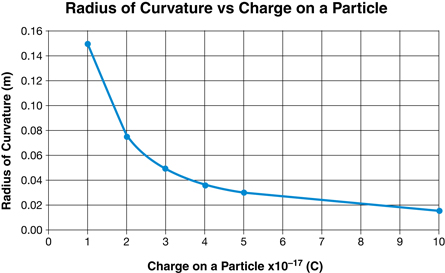
SC 2. With a curved graph, it is difficult to find the magnetic field strength.
SC 3. Again, the data can be graphed in several ways. This graph uses a spreadsheet to graph the points. You may think of better titles for the graph and labels for the axes when you create your own graphs.
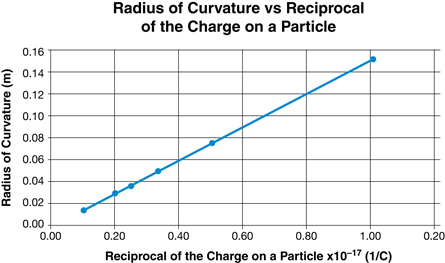
SC 4. This graph is a straight line. The slope of this graph gives an easy way to find the magnetic field strength. The slope is equivalent to ![]() , so the magnetic field strength can be found from
, so the magnetic field strength can be found from ![]() .
.
In this self-check question you used curve straightening to get useful information. You should consider using this technique whenever you need more information from a curved graph.
The Direction of the Magnetic Force
As you discovered earlier, the magnetic force causes the charged particle to travel in uniform circular motion.
 Module 4: Lesson 2 Assignment
Module 4: Lesson 2 Assignment
Remember to submit the answers to A 1 to your teacher as part of your Module 4: Lesson 2 Assignment.
A 1. As a review, draw the inward force on the following diagrams. The first one has been completed as an example.
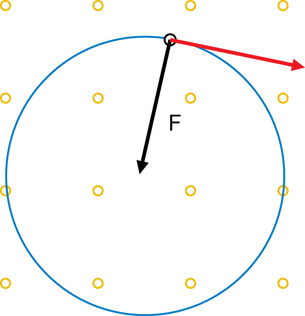
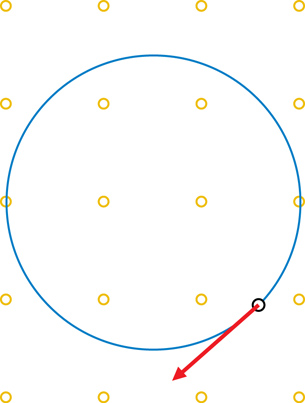
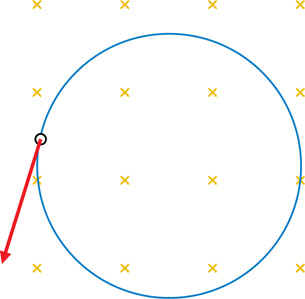
When a charged particle is moving at right angles to a magnetic field, the force exerted on the particle by the field is perpendicular to both the particle's velocity and the magnetic field. Refer again to the diagram on page 594 of the textbook. It may help to think of it this way: two of the quantities will be in the same plane of motion (able to be drawn on the same piece of paper) and the third will be into or out of that plane (the piece of paper).
To predict the direction of the magnetic force, one only needs to know the direction of the particle's velocity and the direction of the magnetic field. However, this does not completely define the direction of the force. There is still an ambiguity because a perpendicular has two directions. This ambiguity is resolved by the left-hand rule illustrated in Figure 2. (There are several hand rules for this purpose. The following is only one suggestion.)
Left-hand Rule for Deflection: The direction of the force exerted on a negatively charged particle moving in a magnetic field can be visualized by the left-hand rule.
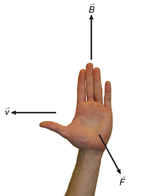
Figure 2
Hold your left hand flat with outstretched fingers in the direction of the magnetic field (![]() ) and with the thumb pointing off to one side in the direction of the particle's velocity (
) and with the thumb pointing off to one side in the direction of the particle's velocity (![]() ). The palm of your hand will then be pointing in the direction of the magnetic force (
). The palm of your hand will then be pointing in the direction of the magnetic force (![]() ).
).
This left-hand rule predicts the force that would act on negative charge. For a positive charge, use your right hand with your fingers, thumb, and palm representing the same quantities.
Example Problem 1.
A negatively charged particle is travelling right in a magnetic field that is directed downward.
-
Is the magnetic force “out of” or “into” the plane of the page?
-
If the particle where positively charged, in what direction would the magnetic force point?
Solution

-
According to the left-hand rule, the force is directed “out of” the plane of the page.
-
For a positive charge, using your right hand, the force would be “into” the plane of the page.
Example Problem 2.
A positively charged particle is travelling left in a magnetic field that is directed downward.
-
Is the magnetic force “out of” or “into” the plane of the page?
-
If the particle where negatively charged, in what direction would the magnetic force point?
Solution
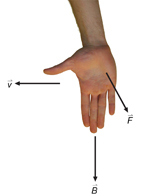
-
According to the right-hand rule, the force is directed “out of” the plane of the page.
-
For a negative charge, using your left hand, the force would be “into” the plane of the page.
 Module 4: Lesson 2 Assignment
Module 4: Lesson 2 Assignment
Remember to submit the answers to A 2 to your teacher as part of your Module 4: Lesson 2 Assignment.
A 2. Predict, draw, and verify the magnetic force on each diagram below. Verify your answers using the simulation.
a. positive charge

b. positive charge

c. negative charge

d. negative charge

A combination of both equation (4) and the appropriate hand rule can be used to determine the magnitude and direction of the magnetic force acting on a moving charged particle. You will need to refer to your physics data sheet for the charge of an electron, proton, and alpha particle. Note the definition of the following terms that apply to the practice problems that follow:
-
“upward” means “out of” the plane of the page (
 ) (not to be confused with the term “north”)
) (not to be confused with the term “north”) -
“downward” means “into” the plane of the page (
 ) (not to be confused with the term “south”)
) (not to be confused with the term “south”)
Example Problem 3.
Calculate the magnitude and direction of the magnetic force acting on a proton travelling north at a speed of 2.75 × 103 m/s through magnetic field of 3.50 × 10–1 T that is directed west.
Magnitude
Fm = qvB
Fm = (1.60 × 10–19 C)(2.75 × 103 m/s)(3.50 × 10–1 T)
Fm = 1.54 × 10–16 N
Direction
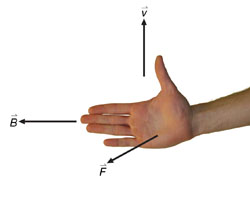
According to the right-hand rule for positive charges, the force is upward.
 Self-Check
Self-Check
SC 5. Based on the following diagram, predict the magnitude and direction of the magnetic force acting on each proton. You can only verify the direction using the simulation.



 Self-Check Answers
Self-Check Answers
SC 5.
a. 
direction: south
Fm = qvB
Fm = (1.60 × 10–19 C)(8.50 × 104 m/s)(2.50 × 10–1 T)
Fm = 3.40 × 10–15 N
b. 
direction: north
Fm = qvB
Fm = (1.60 × 10–19 C)(7.65 × 105 m/s)(5.00 × 10–1 T)
Fm = 6.12 × 10–14 N
c. 
Direction: none
magnitude: none −the motion and field direction are parallel.